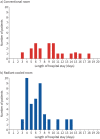An adaptation strategy to urban heat: hospital rooms with radiant cooling accelerate patient recovery
- PMID: 34476248
- PMCID: PMC8405870
- DOI: 10.1183/23120541.00881-2020
An adaptation strategy to urban heat: hospital rooms with radiant cooling accelerate patient recovery
Erratum in
-
Erratum: "An adaptation strategy to urban heat: hospital rooms with radiant cooling accelerate patient recovery". Christina Hoffmann, Uta Liebers, Philipp Humbsch, Marija Drozdek, Georg Bölke, Peter Hoffmann, Adrien Holzgreve, Gavin C. Donaldson and Christian Witt. ERJ Open Res 2021; 7: 00881-2020.ERJ Open Res. 2021 Sep 13;7(3):50881-2020. doi: 10.1183/23120541.50881-2020. eCollection 2021 Jul. ERJ Open Res. 2021. PMID: 34527725 Free PMC article.
Abstract
Background: Patients with respiratory diseases are vulnerable to the effects of heat. Therefore, it is important to develop adaptation strategies for heat exposure. One option is to optimise the indoor environment. To this end, we equipped hospital patient rooms with radiant cooling. We performed a prospective randomised clinical trial to investigate potentially beneficial effects of the hospitalisation in rooms with radiant cooling on patients with a respiratory disease exacerbation.
Methods: Recruitment took place in June, July and August 2014 to 2016 in the Charité - Universitätsmedizin Berlin, Germany. We included patients with COPD, asthma, pulmonary hypertension, interstitial lung disease and pneumonia. 62 patients were allocated to either a standard patient room without air conditioning or a room with radiant cooling set to 23°C (73°F). We analysed the patients' length of stay with a Poisson regression. Physiological parameters, fluid intake and daily step counts were tested with mixed regression models.
Results: Patients hospitalised in a room with radiant cooling were discharged earlier than patients in standard rooms (p=0.003). The study participants in chambers with radiant cooling had a lower body temperature (p=0.002), lower daily fluid intake (p<0.001), higher systolic blood pressure (p<0.001) and an increased daily step count (p<0.001).
Conclusion: The results indicate that a radiant cooling system in hospital patient rooms provides clinical benefits for patients with respiratory disease exacerbations during the warm summer months, which may contribute to an earlier mobilisation. Radiant cooling is commended as a suitable adaptation strategy to reduce the clinical impact of climate warming.
Copyright ©The authors 2021.
Conflict of interest statement
Conflict of interest: C. Hoffmann has nothing to disclose. Conflict of interest: U. Liebers reports personal fees for consultations and lectures from AstraZeneca GmbH, Berlin-Chemie AG, Boehringer Ingelheim GmbH, Bristol-Myers Squibb, GlaxoSmithKline, Novartis Pharma GmbH and Roche Pharma AG. Conflict of interest: P. Humbsch has nothing to disclose. Conflict of interest: M. Drozdek has nothing to disclose. Conflict of interest: G. Bölke has nothing to disclose. Conflict of interest: P. Hoffmann has nothing to disclose. Conflict of interest: A. Holzgreve has nothing to disclose. Conflict of interest: G.C. Donaldson reports grants from AstraZeneca, and personal fees from AstraZeneca, the American Thoracic Society and FWO Flanders, outside the submitted work. Conflict of interest: C. Witt reports grants from Deutsche Forschungsgemeinschaft during the conduct of the study; and personal fees from MSD, AstraZeneca, Bristol-Myers Squibb, GlaxoSmithKline, Takeda and Berlin-Chemie, outside the submitted work.
Figures



References
LinkOut - more resources
Full Text Sources
